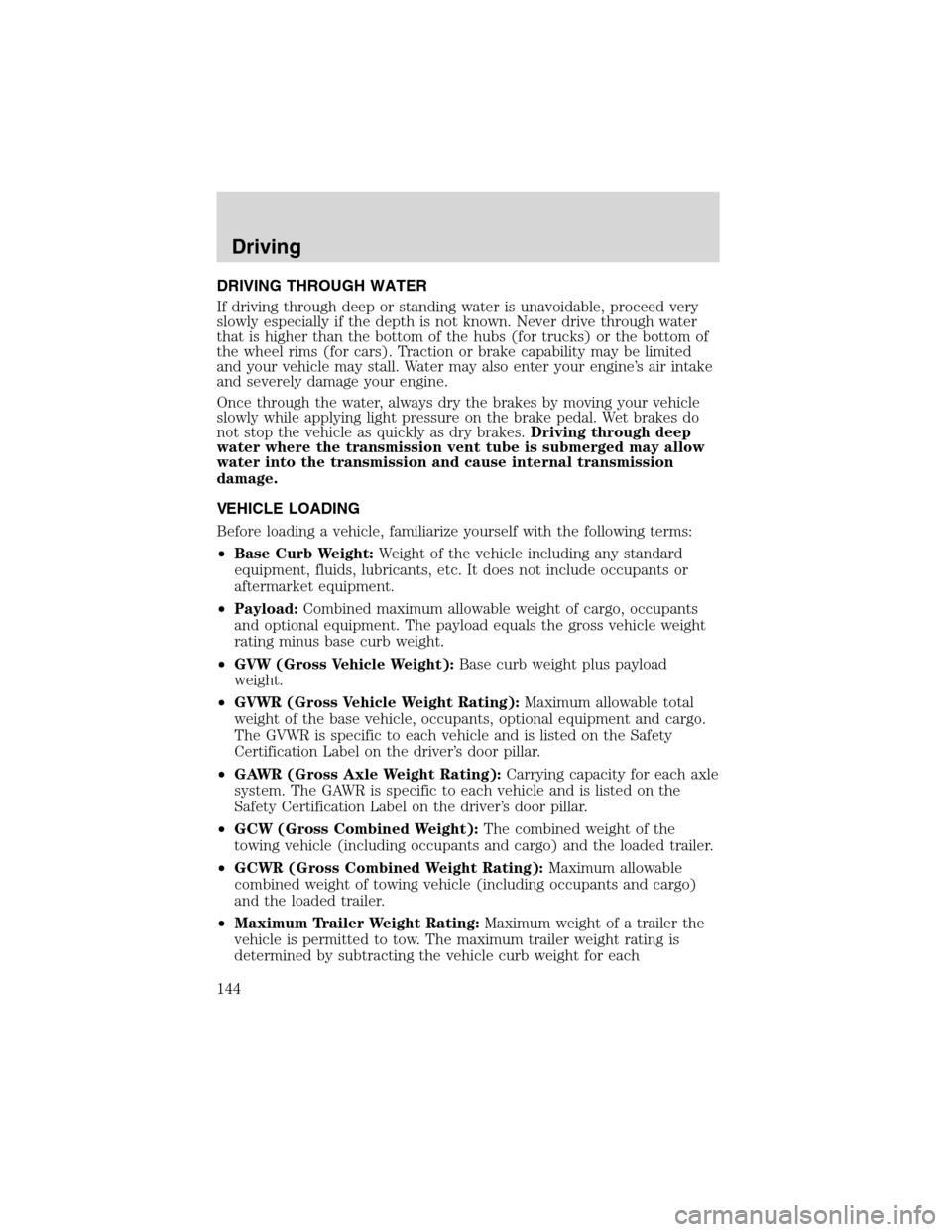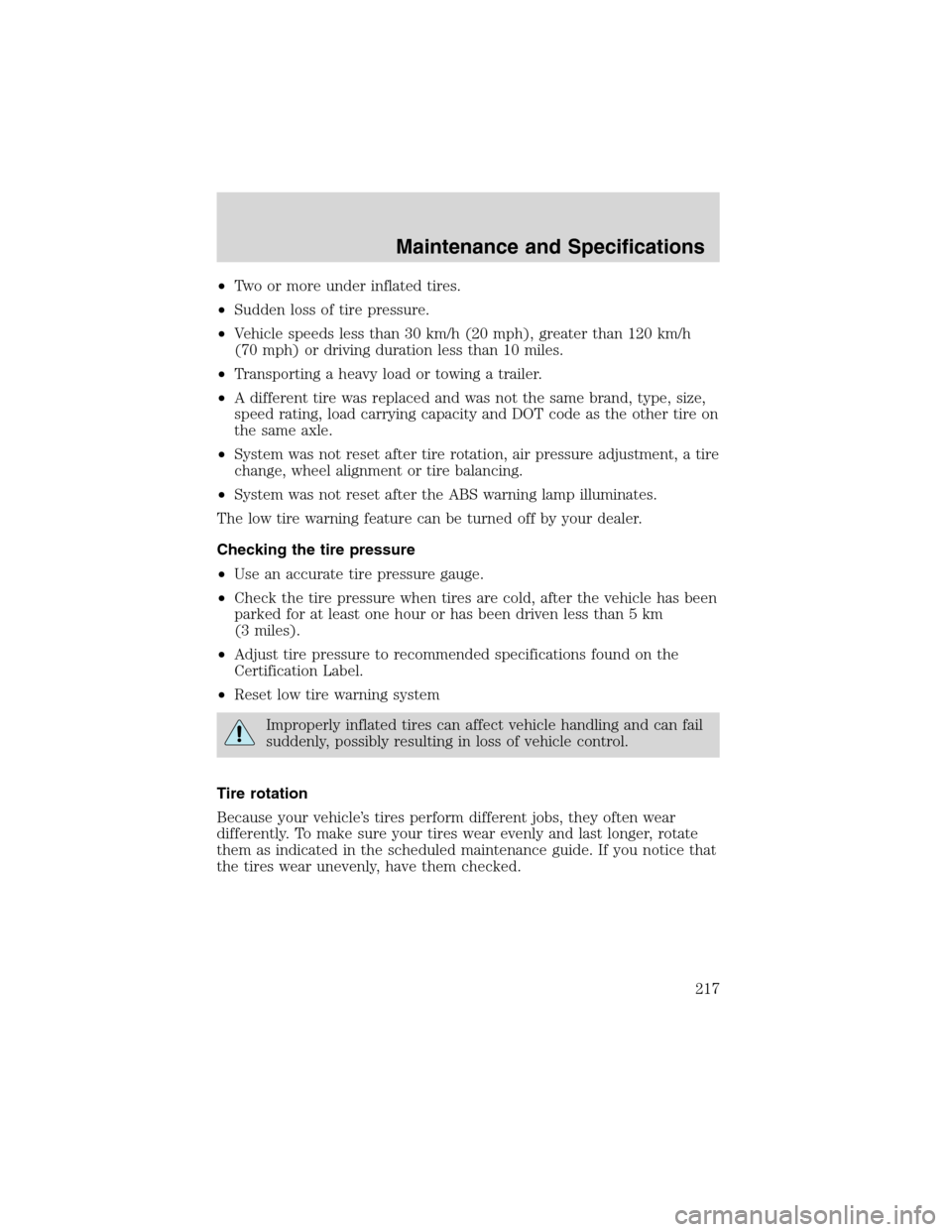Page 144 of 240

DRIVING THROUGH WATER
If driving through deep or standing water is unavoidable, proceed very
slowly especially if the depth is not known. Never drive through water
that is higher than the bottom of the hubs (for trucks) or the bottom of
the wheel rims (for cars). Traction or brake capability may be limited
and your vehicle may stall. Water may also enter your engine’s air intake
and severely damage your engine.
Once through the water, always dry the brakes by moving your vehicle
slowly while applying light pressure on the brake pedal. Wet brakes do
not stop the vehicle as quickly as dry brakes.Driving through deep
water where the transmission vent tube is submerged may allow
water into the transmission and cause internal transmission
damage.
VEHICLE LOADING
Before loading a vehicle, familiarize yourself with the following terms:
•Base Curb Weight:Weight of the vehicle including any standard
equipment, fluids, lubricants, etc. It does not include occupants or
aftermarket equipment.
•Payload:Combined maximum allowable weight of cargo, occupants
and optional equipment. The payload equals the gross vehicle weight
rating minus base curb weight.
•GVW (Gross Vehicle Weight):Base curb weight plus payload
weight.
•GVWR (Gross Vehicle Weight Rating):Maximum allowable total
weight of the base vehicle, occupants, optional equipment and cargo.
The GVWR is specific to each vehicle and is listed on the Safety
Certification Label on the driver’s door pillar.
•GAWR (Gross Axle Weight Rating):Carrying capacity for each axle
system. The GAWR is specific to each vehicle and is listed on the
Safety Certification Label on the driver’s door pillar.
•GCW (Gross Combined Weight):The combined weight of the
towing vehicle (including occupants and cargo) and the loaded trailer.
•GCWR (Gross Combined Weight Rating):Maximum allowable
combined weight of towing vehicle (including occupants and cargo)
and the loaded trailer.
•Maximum Trailer Weight Rating:Maximum weight of a trailer the
vehicle is permitted to tow. The maximum trailer weight rating is
determined by subtracting the vehicle curb weight for each
Driving
144
Page 217 of 240

•Two or more under inflated tires.
•Sudden loss of tire pressure.
•Vehicle speeds less than 30 km/h (20 mph), greater than 120 km/h
(70 mph) or driving duration less than 10 miles.
•Transporting a heavy load or towing a trailer.
•A different tire was replaced and was not the same brand, type, size,
speed rating, load carrying capacity and DOT code as the other tire on
the same axle.
•System was not reset after tire rotation, air pressure adjustment, a tire
change, wheel alignment or tire balancing.
•System was not reset after the ABS warning lamp illuminates.
The low tire warning feature can be turned off by your dealer.
Checking the tire pressure
•Use an accurate tire pressure gauge.
•Check the tire pressure when tires are cold, after the vehicle has been
parked for at least one hour or has been driven less than 5 km
(3 miles).
•Adjust tire pressure to recommended specifications found on the
Certification Label.
•Reset low tire warning system
Improperly inflated tires can affect vehicle handling and can fail
suddenly, possibly resulting in loss of vehicle control.
Tire rotation
Because your vehicle’s tires perform different jobs, they often wear
differently. To make sure your tires wear evenly and last longer, rotate
them as indicated in the scheduled maintenance guide. If you notice that
the tires wear unevenly, have them checked.
Maintenance and Specifications
217
Page 233 of 240

K
Keyless entry system .................81
autolock .....................................81
Keys
positions of the ignition .........131
L
Lamps
autolamp system .......................35
bulb replacement
specifications chart ..................40
cargo lamps ...............................36
daytime running light ...............35
headlamps .................................35
headlamps, flash to pass ..........36
instrument panel, dimming .....36
interior lamps .....................38–39
replacing bulbs .............40, 42–43
Lane change indicator
(see Turn signal) ........................38
Liftgate ..................................72–73
Lights, warning and indicator ....10
anti-lock brakes (ABS) ..........135
Load limits .................................144
GAWR ......................................144
GVWR ......................................144
trailer towing ..........................144
Locks
autolock .....................................81
childproof ..................................76
Low tire warning .................13, 215
Lubricant specifications ...222, 224
Lumbar support, seats ...............89
M
Message center ...........................62english/metric button ...............63
system check button ................63
warning messages .....................65
Mirrors .........................................46
automatic dimming rearview
mirror ........................................51
fold away ...................................52
heated ........................................52
side view mirrors (power) .......51
Motorcraft parts ................205, 220
O
Octane rating ............................204
Oil (see Engine oil) ..................191
Overdrive ...................................139
P
Parking brake ............................135
Parts (see Motorcraft parts) ....220
Passenger Occupant
Classification Sensor ...................99
Pedals (see Power adjustable
foot pedals) .................................53
Power adjustable foot pedals .....53
Power distribution box
(see Fuses) ...............................157
Power door locks ..................75, 81
Power mirrors .............................51
Power point .................................50
Power steering ..........................138
fluid, checking and adding ....211
fluid, refill capacity ................220
fluid, specifications .........222, 224
Power Windows ...........................50
R
Radio ..........................16, 18, 20, 24
Index
233